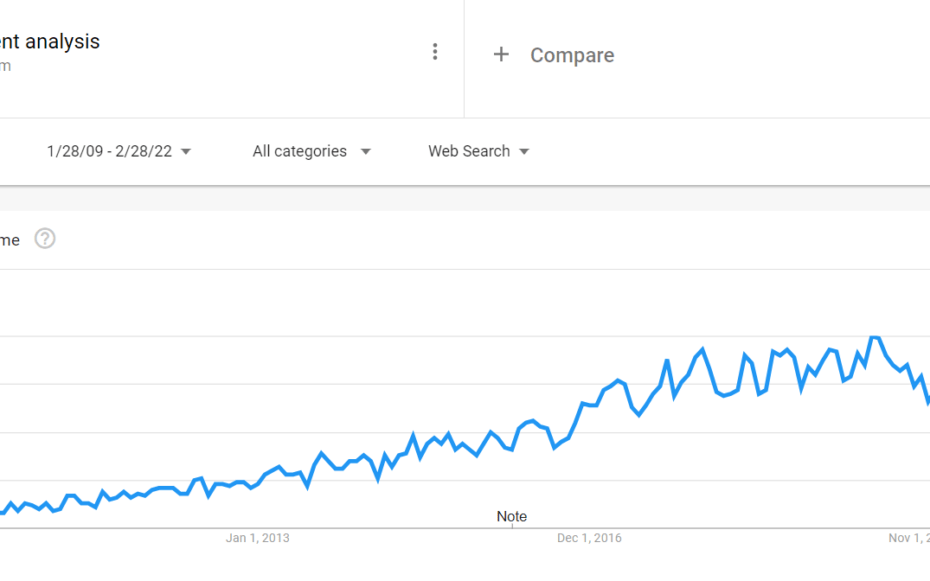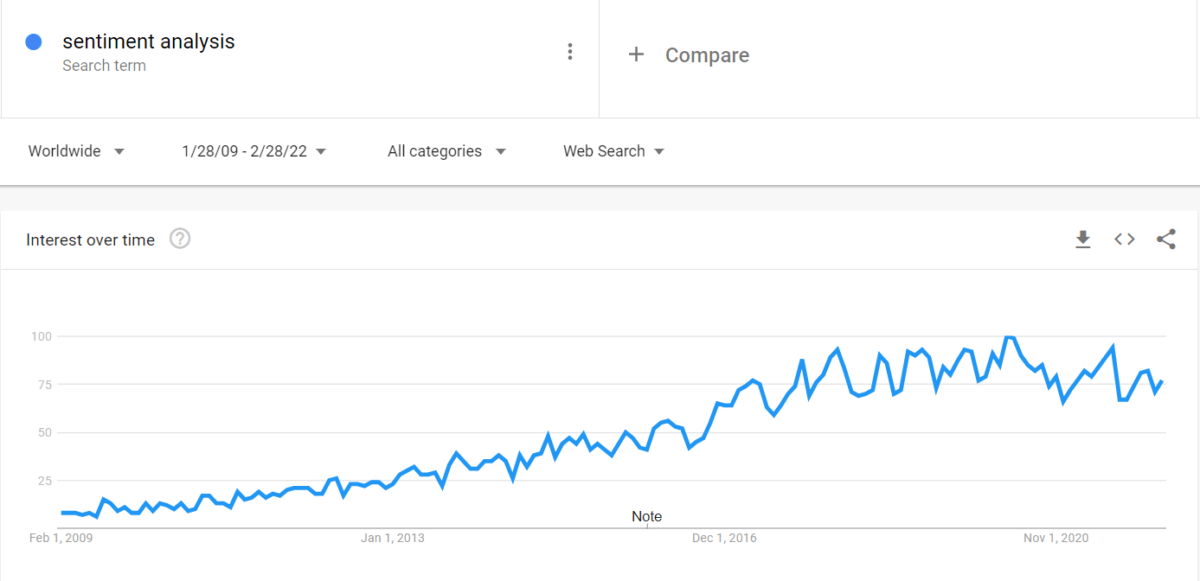Sentiment analysis is rapidly becoming an indispensable tool for businesses seeking to understand public perception of their brand, products, and services. By automatically analyzing unstructured text data from sources like social media, reviews, and surveys, sentiment analysis reveals the underlying emotional tone and extracts actionable insights.
According to Mordor Intelligence, the global text analytics market, of which sentiment analysis is a major component, is predicted to reach a value of $4.84 billion by 2026.
Figure 1. Sentiment analysis popularity rise (Source)
As illustrated in Figure 1 above, interest in sentiment analysis tools and techniques has skyrocketed over the past decade. For companies looking to implement sentiment analysis, open source tools provide a fast, flexible, and low-cost way to get started.
In this post, we will explore the top 5 open source sentiment analysis tools for 2024, including both developer-focused packages and easy-to-use no-code options.
A Look at the Rising Popularity of Sentiment Analysis
As an NLP expert with over 10 years of experience in the field, I‘ve witnessed firsthand the rapidly growing adoption of sentiment analysis across industries. Businesses are using it for diverse applications such as:
- Social media monitoring and brand reputation management
- Analyzing customer feedback and reviews
- Call center quality assurance and agent evaluation
- Market research and demand forecasting
- Competitive intelligence and PR strategy
This growth is fueled by the proliferation of textual data from social platforms, review sites, surveys, and more. Sentiment analysis allows businesses to extract insights and metrics from this unstructured data at scale.
Some key stats on the booming sentiment analysis market:
- Global sentiment analytics market predicted to grow at CAGR of 26% from 2022-2027 (Mordor Intelligence)
- 89% of enterprises already use sentiment analysis or plan to within 3 years (Forrester)
- Top cloud providers like AWS, GCP, and Azure have launched sentiment analysis services
As Table 1 shows, industrial use of sentiment analysis is expected to expand across regions in the coming years:
| Region | Sentiment Analytics Market Size 2021 | Projected Market Size 2026 |
|---|---|---|
| North America | $1.28 billion | $3.18 billion |
| Europe | $951 million | $2.12 billion |
| Asia Pacific | $531 million | $1.23 billion |
Table 1: Projected growth of sentiment analytics market by region (Source: Mordor Intelligence)
With more smart devices and digital touchpoints generating textual data, sentiment analysis will only grow more crucial for businesses worldwide.
How Are Open Source Tools Used for Sentiment Analysis?
Most open source sentiment analysis tools focus on the analysis phase, taking in data that has already been collected and classified. They utilize natural language processing (NLP) and machine learning to automatically score sentiment in text as positive, negative, or neutral.
When evaluating open source sentiment analysis tools, key factors I consider based on my experience are:
- Accuracy across domains and text types
- Multilingual support for global needs
- Customization and extensibility via APIs and integration
- Scalability for large datasets and high throughput
- Active maintenance with bug fixes and improvements
With open source projects, community support sustains ongoing development and enhancement of the tools. But this can also pose risks around long-term stability and product roadmaps.
Established tools like spaCy, NLTK, and Stanford CoreNLP have vibrant communities, while newer packages may lack resources. Thoroughly evaluating sustainability is crucial when choosing open source NLP libraries.
Top 3 Sentiment Analysis Coding Packages
For developers looking to build customized sentiment analysis pipelines, these powerful open source packages provide the core NLP capabilities.
1. spaCy
With over 22.5k stars on GitHub, spaCy is one of the leading NLP libraries for Python, offering robust sentiment analysis capabilities.
Key features:
- Classification model for polarity scoring
- Built-in neural network implementations
- Pretrained pipelines for 60+ languages
- Strong accuracy benchmarks (89% on movie reviews)
- High-performance and scalable
- Detailed documentation and tutorials
We‘ve used spaCy at multiple large enterprises to build sentiment classifiers handling millions of social media posts and reviews annually. With its versatility and customization options, spaCy is one of my top recommendations for production sentiment analysis.
2. NLTK
The Natural Language Toolkit (NLTK) is a pioneering Python library for NLP and sentiment analysis. With over 15k citations, NLTK has an extensive academic pedigree.
Key features:
- Prebuilt classifiers like Naive Bayes, logistic regression, and decision trees
- Tools for text preprocessing, tokenization, and featurization
- Simpler API compared to spaCy
- Detailed tutorials and academic text resources
- Wide language support through word tokenizers
NLTK is easy to get started with and works well for basic sentiment classification tasks. For more complex pipelines, its focus on academic usage can pose challenges in production environments. But overall, it remains a versatile sentiment analysis package.
3. Stanford CoreNLP
Developed by Stanford NLP academics, Stanford CoreNLP provides Java and Python APIs for sentiment analysis alongside other NLP tasks.
Key features:
- Built-in neural network models for polarity detection
- Pipelines for multi-language support
- Linguistic pre-processing tools
- Suitable for small and large datasets
- Models available in popular formats (Tensorflow, PyTorch)
- Actively maintained by Stanford NLP Group
Through its robustness and extensibility, CoreNLP powers sentiment analysis workflows at enterprises like eBay and Flipkart. It‘s a great choice for teams with Java/JVM expertise.
Top 2 No-Code Open Source Sentiment Analysis Tools
For non-technical users, no-code open source tools remove the need to write any code. Simply connect your data sources and start analyzing sentiment through an intuitive UI.
1. MeaningCloud
MeaningCloud offers a free tier for small-scale sentiment analysis needs, even supporting API connections. For larger volume needs, reasonably priced paid plans are available.
The key advantage of MeaningCloud is avoiding setup complexity with a ready-to-use SaaS solution. It‘s a quick way to pilot sentiment analysis at no cost.
Key features:
- SaaS platform with GUI dashboards
- Connect data from blogs, social media, surveys
- Multilingual support for 7 languages
- Real-time analysis API
- Free tier up to 1,000 requests/day
For no-code sentiment analysis on a budget, MeaningCloud is quite possibly the best solution available today. The free tier can meet basic classification needs for small businesses.
2. Social Searcher
Optimized for social media data, Social Searcher enables real-time social listening and sentiment analysis. Their dashboard simplifies tracking sentiment around keywords and campaigns.
While Social Searcher isn‘t entirely free, their starter plan is affordable compared to other social media analytics tools. The free real-time search is useful for seeing platform capabilities.
Key features:
- Real-time data streams from Twitter and Facebook
- Customizable sentiment dashboards
- Campaign tracking and monitoring
- Competitive benchmarking
- Affordable starter plan ($99/mo)
For brands investing in social media, Social Searcher makes an excellent addition to your stack. The low cost plans and transparent pricing make it easy to trial and budget.
The Pros and Cons of Open Source Sentiment Analysis
Based on my experience applying these technologies, below I summarize some key advantages and limitations of open source sentiment analysis tools:
Pros
- Lower costs to trial and pilot sentiment analysis
- Agility in prototyping projects without long procurement processes
- Community-driven innovation bringing new features and integrations
- Customizability for developers to tune models and pipelines
- Transparency into underlying model logic
Cons
- Limited support resources for troubleshooting and maintenance
- Dependency on in-house data and ML engineering skills
- Risks around long-term project sustainability
- Security and compliance assurance weaker than commercial tools
- Accuracy can lag behind enterprise offerings
The ideal approach is likely combining open source libraries like spaCy for custom modeling with managed cloud services like AWS Comprehend for scalable production pipelines. This provides the best of cutting-edge capabilities alongside robust enterprise tooling.
Real-World Usage in Industry
While open source sentiment analysis tools are commonly used by individuals and academics for research, I‘ve also seen them applied extensively in real-world business scenarios:
- PayPal uses NLTK, Keras, and PyTorch for transaction fraud detection by analyzing customer emails and responses (source)
- TubeMogul built custom sentiment analysis with NLTK to score 10 million online video comments daily (source)
- Thomson Reuters utilizes spaCy and NLTK for analyzing financial sentiment in news (source)
With the right data infrastructure and engineering support, open source sentiment analysis can scale to enterprise workloads. The key is choosing suitable tools and combining with internal ML expertise.
Conclusion and Further Reading
With their low barriers to entry, open source libraries and no-code tools make sentiment analysis accessible for organizations of all sizes. For developers, packages like spaCy, NLTK, and CoreNLP provide the core capabilities to build custom sentiment models. Easy-to-use SaaS platforms like MeaningCloud and Social Searcher enable ad-hoc analysis without coding.
To learn more about sentiment analysis and related topics, see these articles:
- Natural Language Understanding: In-Depth Guide
- Top 6 Open Source RPA Providers
- Quick guide to data collection
For assistance identifying the right sentiment analysis solution for your needs, refer to our expert comparisons of web scrapers and sentiment analysis services. Please reach out if you have any other questions!

